Caroline Walsh has an impressive CV – inventor, award-winning dairy farmer, TV personality and mother.
Where to start? She was the winner of TG4’s Feirm Factor in 2010 – bagging herself a new Land Rover Discovery in the process.
Before that, she invented the calf and sheep staller alongside her uncle.
This allows calves and sheep to be restrained up against a gate. The invention won her numerous innovation awards. She is married to Joe and is mother to five children.
Early dairy days
It’s almost incidental to point out she’s also a dairy farmer, and a damn good one at that. Her dairy career started in 2009. She applied for and was successful in being awarded new entrant milk quota. This gave her a milk quota of 200,000l and she started milk production in 2010.
Born and raised on a dairy farm, which is being run by her father and brother, all she ever wanted to be was a dairy farmer. Getting the milk quota enabled her to do just that and, with help from her father, she leased a 28.5ac farm next to the O’Neill family farm in Ballinadee, near Bandon in Co Cork. This is in west Cork and that 0.5ac is important – it’s not 28ac or 29ac, it’s 28.5ac.

Twelve-unit parlour on the farm of Caroline Walsh, Crohane, Ballinascarthy, Co Cork.\ Donal O'Leary
She describes it as being a dream farm – south facing, very free-draining and fertile – the best of west Cork land. Testament to this is the fact that she kept 40 cows on the 28.5ac. An old four-unit parlour was increased in size and a secondhand parlour was installed there.
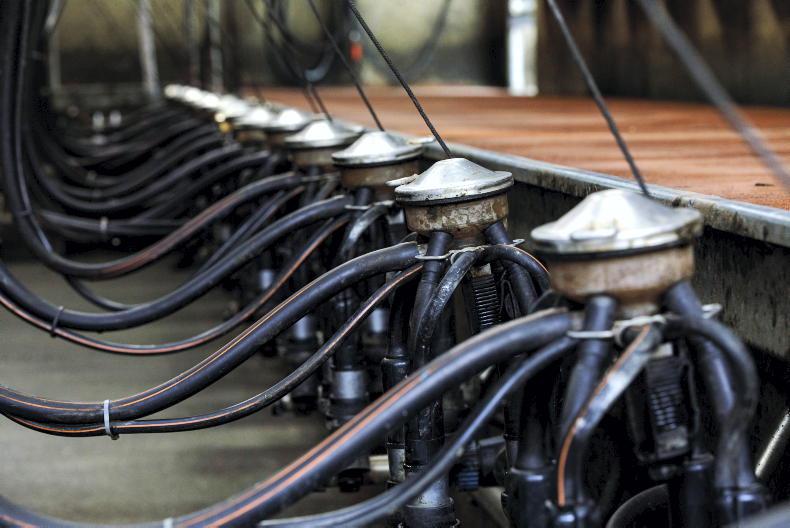
“The parlour came from Tipperary. Dad and the late Sean Connolly got it and I didn’t know what I was getting until it landed in the yard,” Caroline says.
No cow housing was required as the dry cows were transferred out of her herd number and back into the home farm for their winter holiday. They were transferred back into her herd number after calving.
“It was a really easy farm to manage. The cows were grazing from 20 January to 20 November. It was a great farm and anyone could manage it,” Caroline says.
Family life
Getting the farm set up in the winter of 2009 was a busy time for Caroline, but made somewhat easier by the fact that she met her future husband Joe in December of that year, who she describes as being very handy with a welder.
“He was a great help getting us set up in the new parlour, welding the stallwork and making the handling unit. We had only just started going out but he came in very useful,” she jokes.
Independence
Starting out milking on her own gave her independence and an extra income, alongside working full time in the local veterinary office.
The 40 cows came from the home farm, which she describes as her dowry. She’s big into breeding and herd improvement and has now got one of the highest-EBI herds in Ireland.
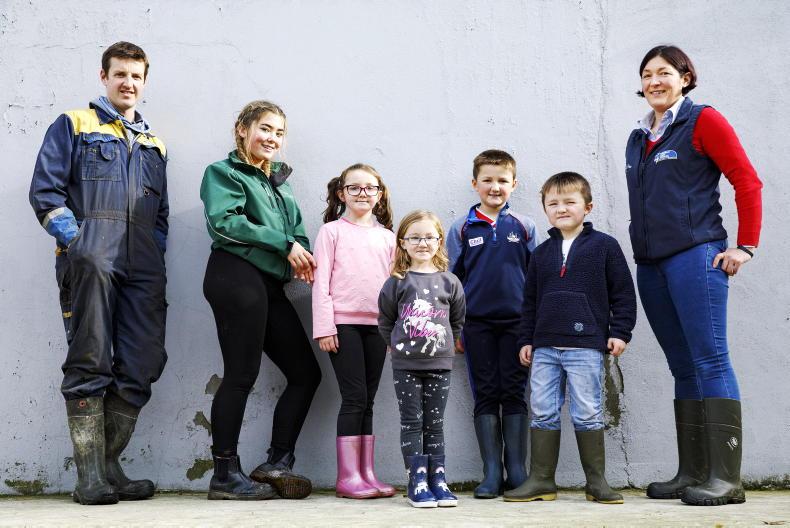
Caroline O' Neill Walsh, Crohane, Ballinascarthy, Co Cork pictured with her husband Joe and children Katelyn, Leanne, Louise, Daniel and Conor. \ Donal O'Leary
Caroline and Joe got married in 2013. Joe is from Ballinascarthy, about 25 minutes west of Ballinadee. Ballinascarthy is famous as being the ancestral home of Henry Ford, of the motor car company fame.
Indeed, the original Ford farmstead is next door to the Walsh farm and, like Henry Ford, the Walsh family are big into machinery, running a large contracting outfit doing grass and maize silage along with running two McHale Fusion round balers.

The contracting business is run by Joe, his brother Paudie and their father Patrick. Up to 10 years ago, the Walsh family were also milking cows on their 20ha home farm but as the contracting got busier they found the time commitments of dairying too intense and, as none of them ever had a real flair for cows, they decided to get out of milk, expand the contracting business and go beef farming instead.
Back to dairying
In 2014, the decision was made to bring the home farm at Ballinascarthy back into dairying. Quotas were being removed in 2015 and the 20ha at Ballinascarthy would allow Caroline to expand her dairy farm, which was limited to just 11.5ha of leased land at Ballinadee.
The plan was to build a new house at Ballinascarthy and make that the family home where both Caroline and Joe worked from and where the children would be raised.
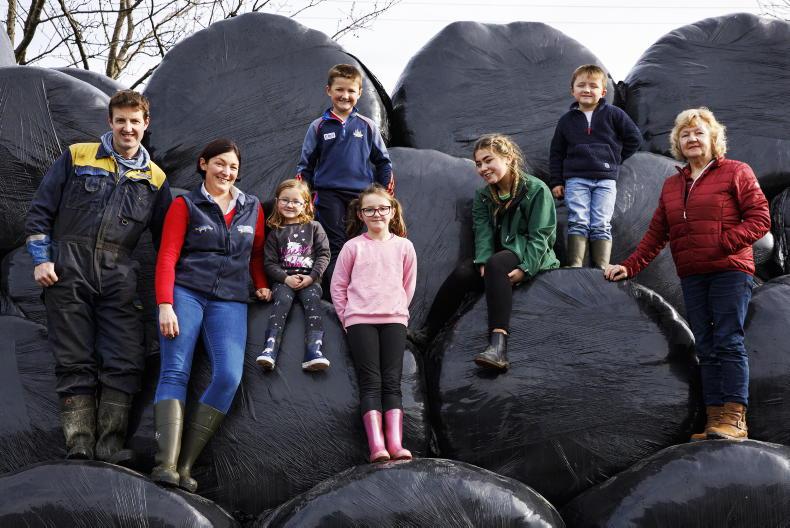
Caroline O' Neill Walsh, Crohane, Ballinascarthy, Co Cork pictured with her husband Joe and children Louise, Daniel, Leanne, Katelyn, Conor and her mother-in law-Ann Walsh.\ Donal O'Leary
Fast forward to 2020 and the Walsh family have five years of milking at Ballinascarthy under their belt. Their new house is built and the family are committed to farming, contracting and the local community. The dairy farm is very much Caroline’s baby – Joe, Patrick and Paudie help out whenever they can but the system is designed around being a one-woman operation.
To get started back into dairying at Ballinascarthy took investment. There was the shell of an old eight-unit parlour on the farm but this was replaced by a new building and a secondhand 16-unit DeLaval parlour was installed along with a secondhand 8,000l bulk tank.
The existing cubicle house which contained 44 cubicles was expanded and there are now 80 cubicles in this shed. One of the main investments was in an underpass.
About 60% of the land is across the road from the farmyard and while it is a relatively minor road, it was one of the pre-conditions that an underpass would be built before cows would return.
This was so there wouldn’t be a need for help to get the cows in for milking – one of the pet hates from the Walsh family’s previous experience of dairy farming.
It’s important to understand that when Joe and the Walsh crew are out on the road doing hire work, the last thing they want is to be getting calls, looking for help or needing something to be fixed back home.
Their way of preventing that from happening is to make sure everything can be run like clockwork, and this is seen throughout the farm.
Grazing infrastructure
The last thing to be done was grazing infrastructure, but most of this was already in place. Roadways were resurfaced and extended where needs be and the water system was upgraded, with extra troughs in some paddocks. Caroline says that the conversion was paid for out of cashflow along with hard work and determination.
Sixty cows were brought from Ballinadee and milked in Ballinascarthy in 2015. Despite having more land at Ballinascarthy, it was a different ballgame farming there compared to Balinadee.
“We fed an awful lot more ration that first year and I only barely ever had enough grass.

“Not all of the land was available for grazing at that time either as there was 10ac of boggy land that was only reclaimed last year.
“Not to take from the farm but it’s not as good as Ballinadee. The soil fertility was lower and the grasses were a good bit older,” Caroline says.
That first spring in Ballinascarthy was difficult. The SCC of the cows in February was as low as 20,000 – their immunity was extremely low and they found it very hard to fight off disease, even a case of mastitis would nearly kill a cow.
“Looking back now, I think it was down to the winter ration. We probably weren’t feeding them as well as they were being fed in Ballinadee. We were feeding wholecrop and thought we were doing things right but cows still ended up getting acidosis.
“At the end of the day I think they were under pressure because we were pushing them too hard. The average yield back then was 7,800l/cow on average and I think it was too hard on them.”
Spring 2016 was also difficult. This time it was the calves that suffered, getting an outbreak of cryptosporidium and rotavirus. Thirteen calves were lost in just three days.
“They ended up getting peritonitis and there was nothing we could do. It was absolutely soul-destroying and something I never want to go through again,” Caroline says.
It’s hard for any farmer to lose stock, but particularly hard for those like Caroline who are really caring for their animals.

Grooved concrete leading to the underpass. \ Donal O'Leary
In order to prevent an outbreak like that happening again, Caroline got on to Joe to make new doors for the calf shed as she suspected a north wind could have predisposed the calves to an infection.
The other thing she did was to separate the calving shed from the calf shed so they no longer share the same airspace. Stockboard sheeting was erected around all the calf pens, baby calves are put under an infrared lamp for 24 hours and calf jackets are used – they must be the happiest calves in Ireland.
Caroline never measured grass in Ballinadee as she felt she never had to, but after moving to Ballinascarthy she found it was something she was struggling with. It seems that Caroline relishes a challenge, so she joined the local grass measuring group organised by Teagasc adviser Mark Treacy.
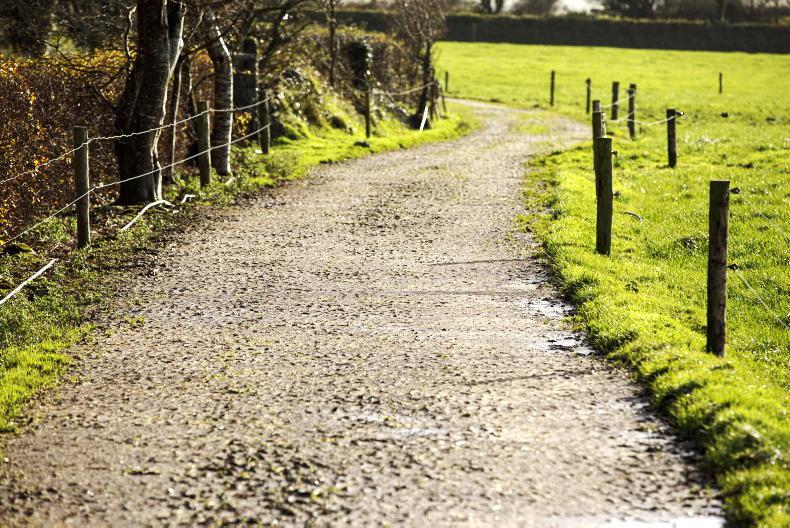
Plenty of good roadways on the farm. \ Donal O'Leary
Part of the trigger for this was that cow numbers had increased and there were over 80 cows milked at peak season in 2018. With 20ha on the milking block, this is a stocking rate of 4.2 cows/ha, which is exceptionally high. Heifers are contract-reared by Caroline’s mother Theresa and are wintered at Ballinascarthy. Silage is produced on the three small outfarms totalling 13ha.
Meal
There was 1.4t of meal fed per cow in 2018. This was due to the high stocking rate and the severe drought. The cows did milk exceptionally well, producing 535kg of milk solids per cow in 2018. But it was stressful.
Caroline wasn’t happy because she had extra work in feeding out silage during the summer and the farm wasn’t as profitable as it could be.
In 2019, cow numbers reduced to 76 cows at peak, which was still a stocking rate of 3.8 cows/ha. She fed 1.1t of meal per cow that year and production dropped to 470kg/cow, but whole milk was fed to all calves, bull calves were sold at 25 days, empties were sold early and cows were milked once a day from 1 October.
“We sold 485,000l of milk in 2017 and we sold 430,000l last year but there was a lot more money in my pocket after last year.
“Protein averaged 3.39% in 2018, it was 3.48% in 2019 and I reckon it’ll average at around 3.6% in 2020. I’m putting this down to improved genetics and more grass in the diet,” Caroline says.
Cow numbers reduced again in 2020 to 72 cows at peak, a stocking rate of 3.6 cows/ha. The empty cows and late-calvers were sold in mid-August so the stocking rate for the autumn was 2.95 cows/ha.
The herd is on track to deliver 500kgMS/cow this year from 850kg of meal and with 44% of the herd first and second lactation. The cows will be milked twice a day this year until dry off because, due to COVID-19 all children’s sporting activities are called off so the necessity for once a day isn’t there in 2020.
Calving
Calving start date on this farm is earlier than most with the first cow due to calve on 14 January.
The reason for this is to have the bulk of the calving out of the way before Joe and the machinery men get busy at the contracting. The busy period for them is from early March to mid-October. The first job is sowing maize. Grass silage is harvested all summer and the maize is harvested in the autumn. 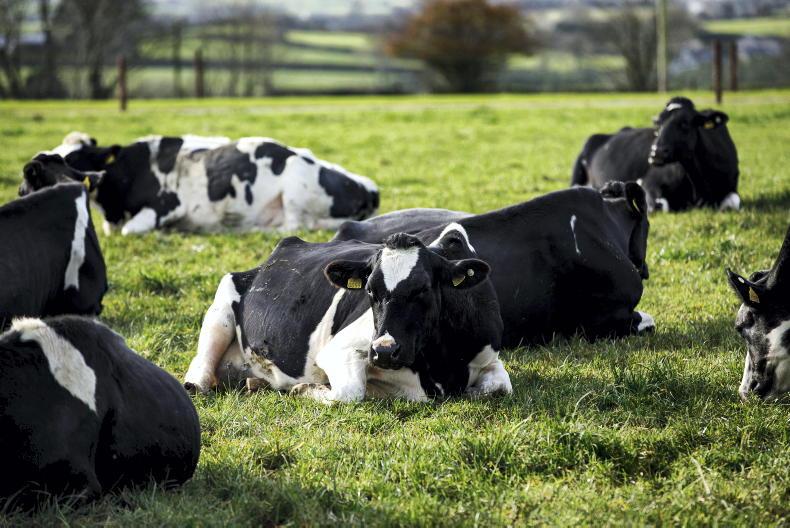
The herd of cows. \ Donal O'Leary
The priority during that period is the contracting work, so the dairy farm is designed to be as easy to operate as possible. Joe spreads fertiliser and any slurry or dirty water on the farm in the evenings or on days not doing hire work.
Most days all of the John Deere tractors are out working, so if Caroline needed a tractor to buffer feed a few round bales, it may not be there.
As mentioned, Caroline is a bit of an inventor, coming up with novel ideas for doing things. It’s the type of farm where there is some nifty little thing around every corner.
She has her own bucket/step/tray combination for dipping clusters and holding essentials in the pit. Joe and Patrick are fierce handy – designing and making manual drafting gates, calf penning and they even have a milk pump and barrel connected to the receiver jar in the pit meaning milk is pumped from the pit directly to the calf shed – so Caroline isn’t lugging buckets around.
Everything is done to make life easy. The underpass, cubicle shed, handling unit and calf shed are all labour efficient.
The plan for 2021 is to milk 64 cows, which will be a stocking rate of 3.2 cows/ha. Caroline reckons the herd should produce around 540kgMS/cow next year, from around 850kg of meal. Her herd EBI is one of the highest in the country at €174. At this stage nearly all of the herd is genotyped and one bull calf was sold to an AI company this spring.
The cows
She’s passionate about cows and breeding and is happiest standing in the field talking about the cows. She knows them all individually, Caroline and the kids refer to them as “Dolly Birds” they are so well looked after.

Caroline is milking a couple of Jersey crossbred cows but has concentrated her breeding efforts over the last few years on Holstein Friesian, getting the herd upgraded to pedigree status this year and classified last summer. The highest-classified cow (excellent) is Margo and she is also the children’s favourite.
Selling stock is likely to become a bigger part of the farm business in years to come, both to AI companies and also to dairy farmers.
“I reckon there’s a market for the pedigree-registered and classified animals and I also reckon there’s a market for the high-EBI animal and I think we can provide both. I’m going to use all Holstein Friesian AI next year, except on the slow milkers – they’ll get a beef straw.
“I sold heifer calves last spring for €385 at six weeks of age.
“Long term, I might keep more heifer calves and sell them as in-calf heifers.”
Despite their high yield potential, the cows in the herd are not extremely big. Caroline is part of the Greenbreed programme with ICBF so the herd were weighed and the average weight in midsummer, including the first-lactation cows, was 530kg.
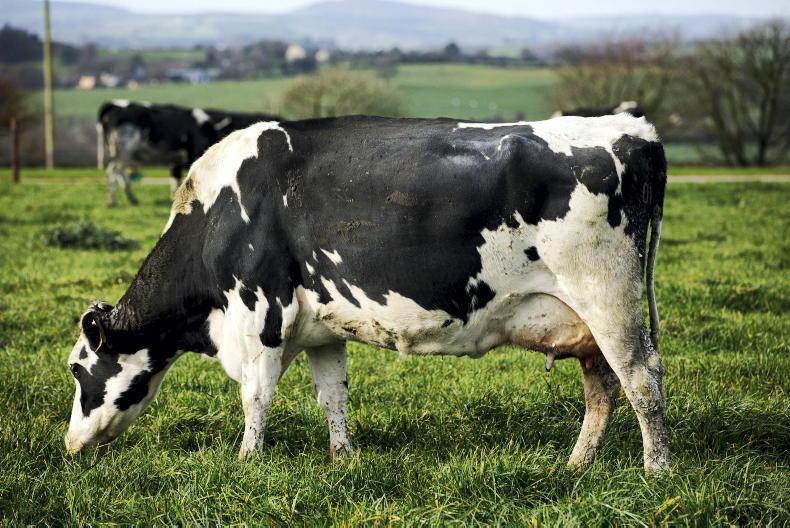
You could probably add another 30kg or 40kg of liveweight if the herd was more mature. It’s still a very efficient animal given the level of production.
Smaxtec heat detection devices were purchased in 2018 and Caroline relies on these for heat detection, health detection and proximity to calving.
There are no bulls on the farm and all-AI is practised. She was a bit disappointed with how breeding went this year as some cows that were in calf for January lost their pregnancy.
Grazing
Four years after joining the grass group, Caroline has definitely cracked the skill.
Last year, the farm grew 16.3tDM/ha and she achieved an average of 10.7 grazings per year, one of the highest number of grazings in the Grassland Farmer of the Year competition.
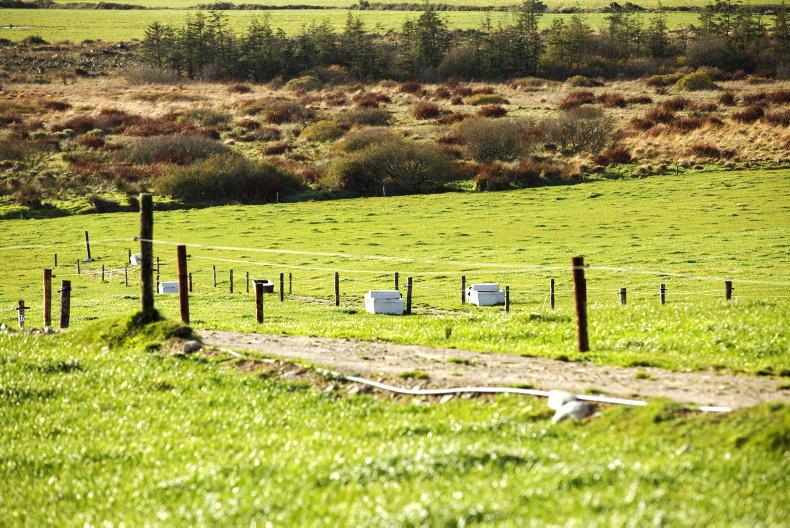
She spread an average of 250kgN/ha across the milking platform, something she is hoping to reduce in coming years as more clover is incorporated. She feels that just two-thirds of the current fertiliser use would be required if there was more clover on the farm.
Milking is Caroline’s favourite job. With 16 units it’ll be just four rows next year. It currently takes 45 minutes to do the milking and it’s Caroline’s break from the house.
She’s happy milking and she says Joe is happy on the Volvo. It’s a marriage made in heaven – cows and machinery in the one yard, working in perfect harmony to deliver a future for themselves and their family.
It’s a real family farm. Caroline says she wouldn’t be able to do it without the help of Joe’s mother Ann, who’s “mighty for baby-sitting, dinner-making and sharing the workload”.
This article originally appeared in the Irish Dairy Farmer magazine 2021 Annual. This publication is available to purchase here Irish Dairy Farmer magazine
Caroline Walsh has an impressive CV – inventor, award-winning dairy farmer, TV personality and mother.
Where to start? She was the winner of TG4’s Feirm Factor in 2010 – bagging herself a new Land Rover Discovery in the process.
Before that, she invented the calf and sheep staller alongside her uncle.
This allows calves and sheep to be restrained up against a gate. The invention won her numerous innovation awards. She is married to Joe and is mother to five children.
Early dairy days
It’s almost incidental to point out she’s also a dairy farmer, and a damn good one at that. Her dairy career started in 2009. She applied for and was successful in being awarded new entrant milk quota. This gave her a milk quota of 200,000l and she started milk production in 2010.
Born and raised on a dairy farm, which is being run by her father and brother, all she ever wanted to be was a dairy farmer. Getting the milk quota enabled her to do just that and, with help from her father, she leased a 28.5ac farm next to the O’Neill family farm in Ballinadee, near Bandon in Co Cork. This is in west Cork and that 0.5ac is important – it’s not 28ac or 29ac, it’s 28.5ac.

Twelve-unit parlour on the farm of Caroline Walsh, Crohane, Ballinascarthy, Co Cork.\ Donal O'Leary
She describes it as being a dream farm – south facing, very free-draining and fertile – the best of west Cork land. Testament to this is the fact that she kept 40 cows on the 28.5ac. An old four-unit parlour was increased in size and a secondhand parlour was installed there.

“The parlour came from Tipperary. Dad and the late Sean Connolly got it and I didn’t know what I was getting until it landed in the yard,” Caroline says.
No cow housing was required as the dry cows were transferred out of her herd number and back into the home farm for their winter holiday. They were transferred back into her herd number after calving.
“It was a really easy farm to manage. The cows were grazing from 20 January to 20 November. It was a great farm and anyone could manage it,” Caroline says.
Family life
Getting the farm set up in the winter of 2009 was a busy time for Caroline, but made somewhat easier by the fact that she met her future husband Joe in December of that year, who she describes as being very handy with a welder.
“He was a great help getting us set up in the new parlour, welding the stallwork and making the handling unit. We had only just started going out but he came in very useful,” she jokes.
Independence
Starting out milking on her own gave her independence and an extra income, alongside working full time in the local veterinary office.
The 40 cows came from the home farm, which she describes as her dowry. She’s big into breeding and herd improvement and has now got one of the highest-EBI herds in Ireland.

Caroline O' Neill Walsh, Crohane, Ballinascarthy, Co Cork pictured with her husband Joe and children Katelyn, Leanne, Louise, Daniel and Conor. \ Donal O'Leary
Caroline and Joe got married in 2013. Joe is from Ballinascarthy, about 25 minutes west of Ballinadee. Ballinascarthy is famous as being the ancestral home of Henry Ford, of the motor car company fame.
Indeed, the original Ford farmstead is next door to the Walsh farm and, like Henry Ford, the Walsh family are big into machinery, running a large contracting outfit doing grass and maize silage along with running two McHale Fusion round balers.

The contracting business is run by Joe, his brother Paudie and their father Patrick. Up to 10 years ago, the Walsh family were also milking cows on their 20ha home farm but as the contracting got busier they found the time commitments of dairying too intense and, as none of them ever had a real flair for cows, they decided to get out of milk, expand the contracting business and go beef farming instead.
Back to dairying
In 2014, the decision was made to bring the home farm at Ballinascarthy back into dairying. Quotas were being removed in 2015 and the 20ha at Ballinascarthy would allow Caroline to expand her dairy farm, which was limited to just 11.5ha of leased land at Ballinadee.
The plan was to build a new house at Ballinascarthy and make that the family home where both Caroline and Joe worked from and where the children would be raised.

Caroline O' Neill Walsh, Crohane, Ballinascarthy, Co Cork pictured with her husband Joe and children Louise, Daniel, Leanne, Katelyn, Conor and her mother-in law-Ann Walsh.\ Donal O'Leary
Fast forward to 2020 and the Walsh family have five years of milking at Ballinascarthy under their belt. Their new house is built and the family are committed to farming, contracting and the local community. The dairy farm is very much Caroline’s baby – Joe, Patrick and Paudie help out whenever they can but the system is designed around being a one-woman operation.
To get started back into dairying at Ballinascarthy took investment. There was the shell of an old eight-unit parlour on the farm but this was replaced by a new building and a secondhand 16-unit DeLaval parlour was installed along with a secondhand 8,000l bulk tank.
The existing cubicle house which contained 44 cubicles was expanded and there are now 80 cubicles in this shed. One of the main investments was in an underpass.
About 60% of the land is across the road from the farmyard and while it is a relatively minor road, it was one of the pre-conditions that an underpass would be built before cows would return.
This was so there wouldn’t be a need for help to get the cows in for milking – one of the pet hates from the Walsh family’s previous experience of dairy farming.
It’s important to understand that when Joe and the Walsh crew are out on the road doing hire work, the last thing they want is to be getting calls, looking for help or needing something to be fixed back home.
Their way of preventing that from happening is to make sure everything can be run like clockwork, and this is seen throughout the farm.
Grazing infrastructure
The last thing to be done was grazing infrastructure, but most of this was already in place. Roadways were resurfaced and extended where needs be and the water system was upgraded, with extra troughs in some paddocks. Caroline says that the conversion was paid for out of cashflow along with hard work and determination.
Sixty cows were brought from Ballinadee and milked in Ballinascarthy in 2015. Despite having more land at Ballinascarthy, it was a different ballgame farming there compared to Balinadee.
“We fed an awful lot more ration that first year and I only barely ever had enough grass.

“Not all of the land was available for grazing at that time either as there was 10ac of boggy land that was only reclaimed last year.
“Not to take from the farm but it’s not as good as Ballinadee. The soil fertility was lower and the grasses were a good bit older,” Caroline says.
That first spring in Ballinascarthy was difficult. The SCC of the cows in February was as low as 20,000 – their immunity was extremely low and they found it very hard to fight off disease, even a case of mastitis would nearly kill a cow.
“Looking back now, I think it was down to the winter ration. We probably weren’t feeding them as well as they were being fed in Ballinadee. We were feeding wholecrop and thought we were doing things right but cows still ended up getting acidosis.
“At the end of the day I think they were under pressure because we were pushing them too hard. The average yield back then was 7,800l/cow on average and I think it was too hard on them.”
Spring 2016 was also difficult. This time it was the calves that suffered, getting an outbreak of cryptosporidium and rotavirus. Thirteen calves were lost in just three days.
“They ended up getting peritonitis and there was nothing we could do. It was absolutely soul-destroying and something I never want to go through again,” Caroline says.
It’s hard for any farmer to lose stock, but particularly hard for those like Caroline who are really caring for their animals.

Grooved concrete leading to the underpass. \ Donal O'Leary
In order to prevent an outbreak like that happening again, Caroline got on to Joe to make new doors for the calf shed as she suspected a north wind could have predisposed the calves to an infection.
The other thing she did was to separate the calving shed from the calf shed so they no longer share the same airspace. Stockboard sheeting was erected around all the calf pens, baby calves are put under an infrared lamp for 24 hours and calf jackets are used – they must be the happiest calves in Ireland.
Caroline never measured grass in Ballinadee as she felt she never had to, but after moving to Ballinascarthy she found it was something she was struggling with. It seems that Caroline relishes a challenge, so she joined the local grass measuring group organised by Teagasc adviser Mark Treacy.

Plenty of good roadways on the farm. \ Donal O'Leary
Part of the trigger for this was that cow numbers had increased and there were over 80 cows milked at peak season in 2018. With 20ha on the milking block, this is a stocking rate of 4.2 cows/ha, which is exceptionally high. Heifers are contract-reared by Caroline’s mother Theresa and are wintered at Ballinascarthy. Silage is produced on the three small outfarms totalling 13ha.
Meal
There was 1.4t of meal fed per cow in 2018. This was due to the high stocking rate and the severe drought. The cows did milk exceptionally well, producing 535kg of milk solids per cow in 2018. But it was stressful.
Caroline wasn’t happy because she had extra work in feeding out silage during the summer and the farm wasn’t as profitable as it could be.
In 2019, cow numbers reduced to 76 cows at peak, which was still a stocking rate of 3.8 cows/ha. She fed 1.1t of meal per cow that year and production dropped to 470kg/cow, but whole milk was fed to all calves, bull calves were sold at 25 days, empties were sold early and cows were milked once a day from 1 October.
“We sold 485,000l of milk in 2017 and we sold 430,000l last year but there was a lot more money in my pocket after last year.
“Protein averaged 3.39% in 2018, it was 3.48% in 2019 and I reckon it’ll average at around 3.6% in 2020. I’m putting this down to improved genetics and more grass in the diet,” Caroline says.
Cow numbers reduced again in 2020 to 72 cows at peak, a stocking rate of 3.6 cows/ha. The empty cows and late-calvers were sold in mid-August so the stocking rate for the autumn was 2.95 cows/ha.
The herd is on track to deliver 500kgMS/cow this year from 850kg of meal and with 44% of the herd first and second lactation. The cows will be milked twice a day this year until dry off because, due to COVID-19 all children’s sporting activities are called off so the necessity for once a day isn’t there in 2020.
Calving
Calving start date on this farm is earlier than most with the first cow due to calve on 14 January.
The reason for this is to have the bulk of the calving out of the way before Joe and the machinery men get busy at the contracting. The busy period for them is from early March to mid-October. The first job is sowing maize. Grass silage is harvested all summer and the maize is harvested in the autumn. 
The herd of cows. \ Donal O'Leary
The priority during that period is the contracting work, so the dairy farm is designed to be as easy to operate as possible. Joe spreads fertiliser and any slurry or dirty water on the farm in the evenings or on days not doing hire work.
Most days all of the John Deere tractors are out working, so if Caroline needed a tractor to buffer feed a few round bales, it may not be there.
As mentioned, Caroline is a bit of an inventor, coming up with novel ideas for doing things. It’s the type of farm where there is some nifty little thing around every corner.
She has her own bucket/step/tray combination for dipping clusters and holding essentials in the pit. Joe and Patrick are fierce handy – designing and making manual drafting gates, calf penning and they even have a milk pump and barrel connected to the receiver jar in the pit meaning milk is pumped from the pit directly to the calf shed – so Caroline isn’t lugging buckets around.
Everything is done to make life easy. The underpass, cubicle shed, handling unit and calf shed are all labour efficient.
The plan for 2021 is to milk 64 cows, which will be a stocking rate of 3.2 cows/ha. Caroline reckons the herd should produce around 540kgMS/cow next year, from around 850kg of meal. Her herd EBI is one of the highest in the country at €174. At this stage nearly all of the herd is genotyped and one bull calf was sold to an AI company this spring.
The cows
She’s passionate about cows and breeding and is happiest standing in the field talking about the cows. She knows them all individually, Caroline and the kids refer to them as “Dolly Birds” they are so well looked after.

Caroline is milking a couple of Jersey crossbred cows but has concentrated her breeding efforts over the last few years on Holstein Friesian, getting the herd upgraded to pedigree status this year and classified last summer. The highest-classified cow (excellent) is Margo and she is also the children’s favourite.
Selling stock is likely to become a bigger part of the farm business in years to come, both to AI companies and also to dairy farmers.
“I reckon there’s a market for the pedigree-registered and classified animals and I also reckon there’s a market for the high-EBI animal and I think we can provide both. I’m going to use all Holstein Friesian AI next year, except on the slow milkers – they’ll get a beef straw.
“I sold heifer calves last spring for €385 at six weeks of age.
“Long term, I might keep more heifer calves and sell them as in-calf heifers.”
Despite their high yield potential, the cows in the herd are not extremely big. Caroline is part of the Greenbreed programme with ICBF so the herd were weighed and the average weight in midsummer, including the first-lactation cows, was 530kg.

You could probably add another 30kg or 40kg of liveweight if the herd was more mature. It’s still a very efficient animal given the level of production.
Smaxtec heat detection devices were purchased in 2018 and Caroline relies on these for heat detection, health detection and proximity to calving.
There are no bulls on the farm and all-AI is practised. She was a bit disappointed with how breeding went this year as some cows that were in calf for January lost their pregnancy.
Grazing
Four years after joining the grass group, Caroline has definitely cracked the skill.
Last year, the farm grew 16.3tDM/ha and she achieved an average of 10.7 grazings per year, one of the highest number of grazings in the Grassland Farmer of the Year competition.

She spread an average of 250kgN/ha across the milking platform, something she is hoping to reduce in coming years as more clover is incorporated. She feels that just two-thirds of the current fertiliser use would be required if there was more clover on the farm.
Milking is Caroline’s favourite job. With 16 units it’ll be just four rows next year. It currently takes 45 minutes to do the milking and it’s Caroline’s break from the house.
She’s happy milking and she says Joe is happy on the Volvo. It’s a marriage made in heaven – cows and machinery in the one yard, working in perfect harmony to deliver a future for themselves and their family.
It’s a real family farm. Caroline says she wouldn’t be able to do it without the help of Joe’s mother Ann, who’s “mighty for baby-sitting, dinner-making and sharing the workload”.
This article originally appeared in the Irish Dairy Farmer magazine 2021 Annual. This publication is available to purchase here Irish Dairy Farmer magazine















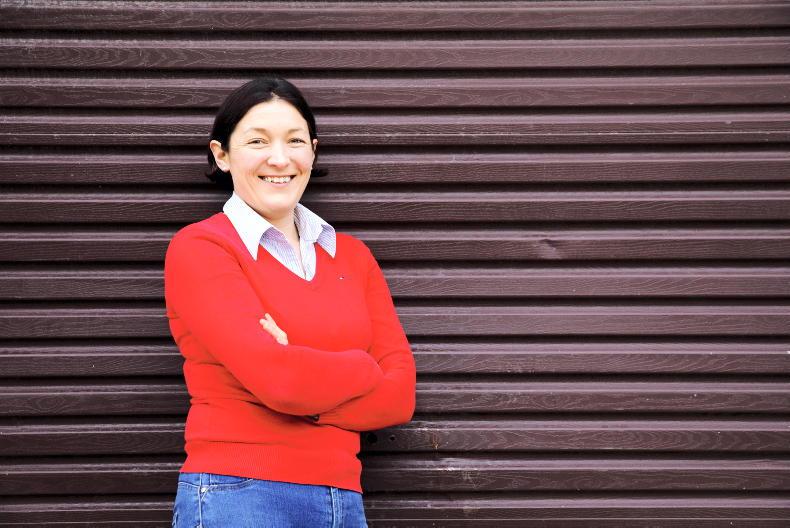

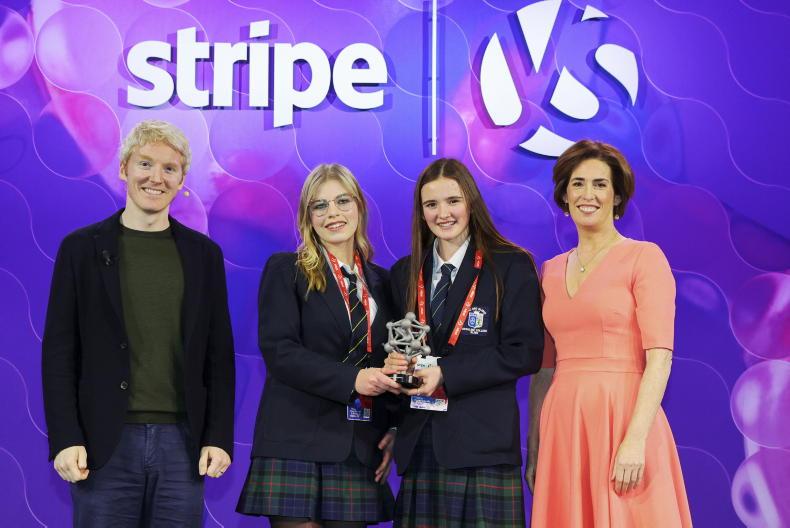
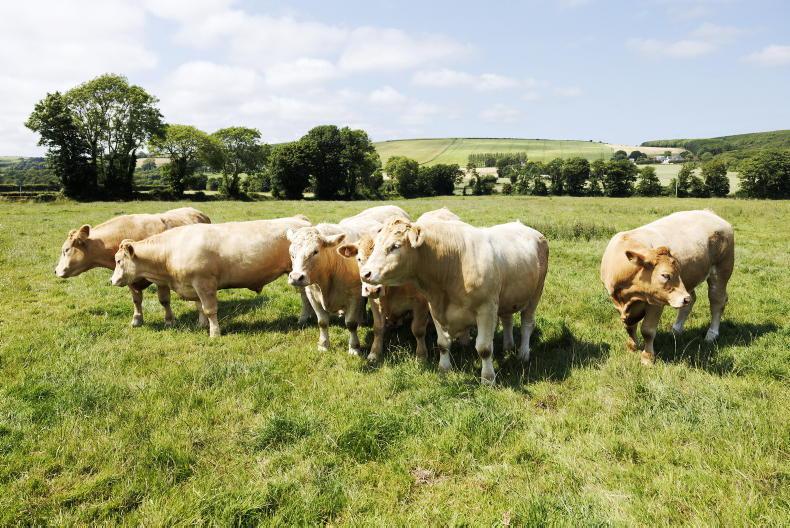
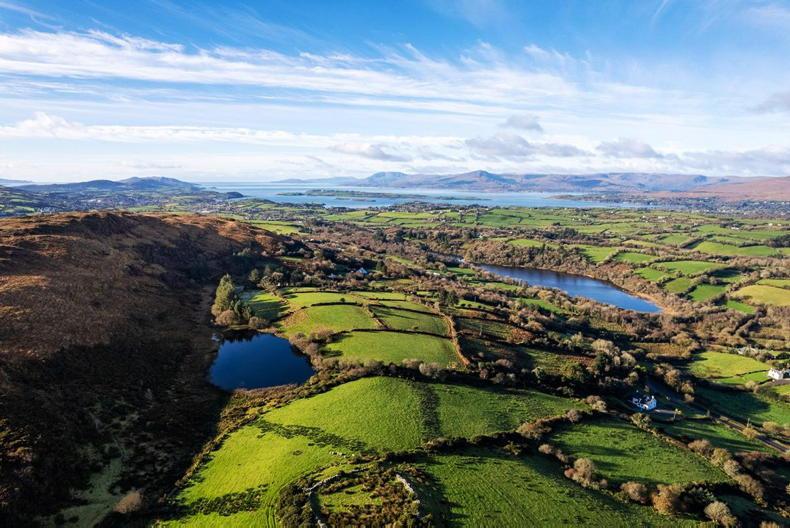
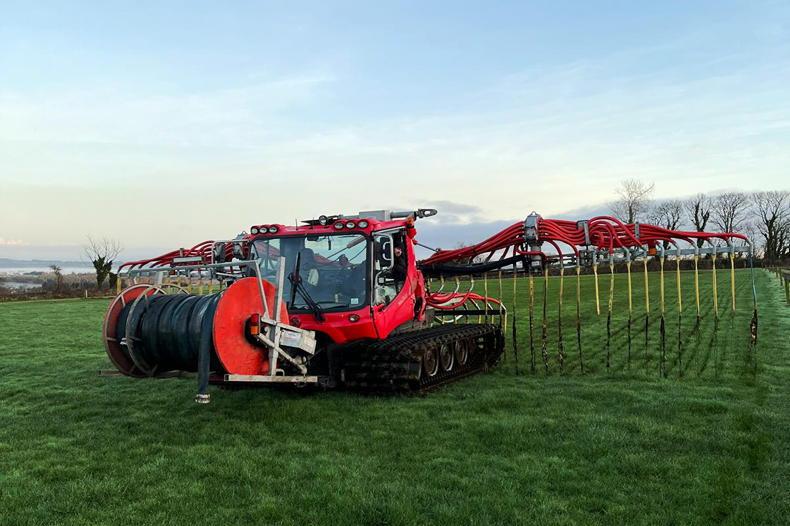
SHARING OPTIONS